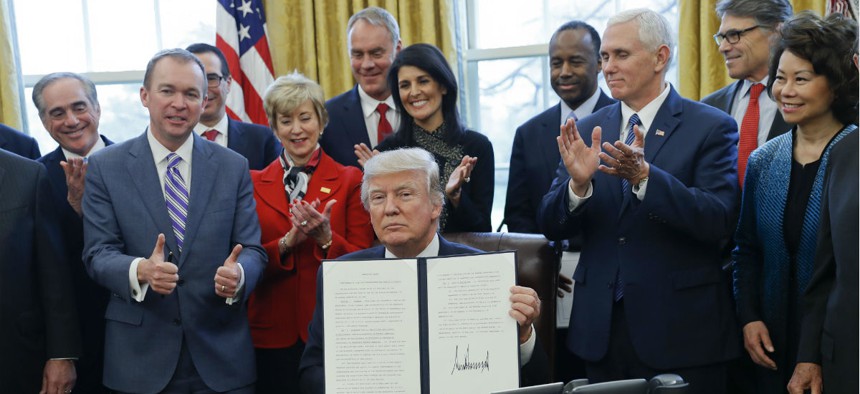Some Agencies Say Reform Plans Won’t Focus on Job Cuts, Layoffs Unlikely
HR leaders say they will find new jobs for anyone whose function is eliminated.
Top personnel officials at several federal agencies said on Wednesday they are not focusing on cutting their workforces as part of their reorganization plans required by President Trump, and vowed to work with any employees whose jobs are consolidated to find them new positions within their organizations.
While the human capital leaders promised to fight to maintain the resources they currently have, they acknowledged they planned to decentralize some key functions to reduce bureaucratic layers. Still, the human resources officials said they were not focusing on cutting their full-time staff and expressed confidence no one would have to leave their agencies involuntarily through layoffs. The officials deflected the spotlight away from the workforce reductions despite a memorandum from the Office of Management and Budget, issued in response to a Trump executive order, which called for a “comprehensive plan for reforming the federal government reducing the federal civilian workforce.”
“We're not going in with the mindset of cutting [full-time equivalents],” said Raymond Limon, the Interior Department’s Human Resources Office director, at an event in Washington, D.C., sponsored by Government Executive. He added, however, there was “no doubt” Interior would be working to meet its budget. The department’s own blueprint for fiscal 2018 called for a 12 percent cut to its budget and a reduction of 4,100 employees.
Still, Limon said after the panel discussion Interior was identifying “some efficiencies” but that it was “not looking to do major reductions in 2019.” Agency reform plans, which were submitted to OMB earlier this month, were required to lay out both short-term and long-term plans to cut their workforces as part of their fiscal 2019 budget submissions. For now, Limon said, Interior is focusing on not filling vacancies in its D.C. and Denver offices. Interior Secretary Ryan Zinke previously told Congress his department will use separation incentives and left the door open to layoffs. House Republicans included in an appropriations bill language authorizing Interior to offer early retirement and buyouts.
Instead of directed efforts, the HR officials said their agencies would rely on natural attrition to trim their rolls.
“I’m very confident at the end of this there won’t be unwanted attrition,” said Veterans Affairs Department Assistant Secretary in the Office of Human Resources and Administration Peter Shelby, “so people won’t be [laid off through a reduction in force] and put out of a job.”
Shelby was clear VA, which is not facing the same budget pressures as most agencies under Trump, would force some employees to move around. The department has already consolidated its central HR office at its Washington headquarters, but will have all of the roughly 30 employees affected in new jobs by Oct. 1. None of those workers will have to relocate, Shelby said.
VA may have difficulty scaling that model, as Shelby added VA eventually plans to cut its HR operation in half. It currently employs 7,000 human resources employees.
“As large as we are, we are pretty adept at placing people,” he said. If the department eventually has to relocate people, Shelby added, “We have the resources to do that.”
HR is not the only area VA is looking to “shrink the administrative footprint in D.C.,” Shelby said. The department has already consolidated the offices of Public and Intergovernmental Affairs and Congressional and Legislative Affairs.
Elias Hernandez, the chief human capital officer at the Small Business Administration, said his agency has already informed its employees it will not engage in any buyouts, early retirement offers or RIFs.
“We will be in alignment with our budget, Hernandez said. “Our budget will obviously be decreased slightly. So we will have to look within the organization to figure out how to reduce FTEs slightly.” He said this will be accomplished only through naturally occurring attrition.
While agencies are trying to send the message to employees they should not be concerned about their jobs, their workforces remain nervous. Office of Personnel Management officials have said agency leaders have told them privately they are “pretty certain” layoffs are coming and are preparing the best strategy to put them in place.
“They’re scared,” Shelby said of the federal workforce. “They’re flat out scared.”
The officials all stressed the need to be transparent about their plans and to engage in open dialogues with their employees to both keep them informed and to solicit ideas. So far, however, they have not yet shared those proposals with their workers and will not release the reform plans publicly until the White House submits its fiscal 2019 budget to Congress next year.
“We have a communication plan that is going to be rolled out,” Hernandez said.
Federal agencies have so far failed to engage with federal employees’ representatives as they have pieced together their reform plans, according to several labor unions. Shelby said VA has communicated with groups representing its employees when required by collective bargaining agreements, but otherwise would rather speak directly to employees.




